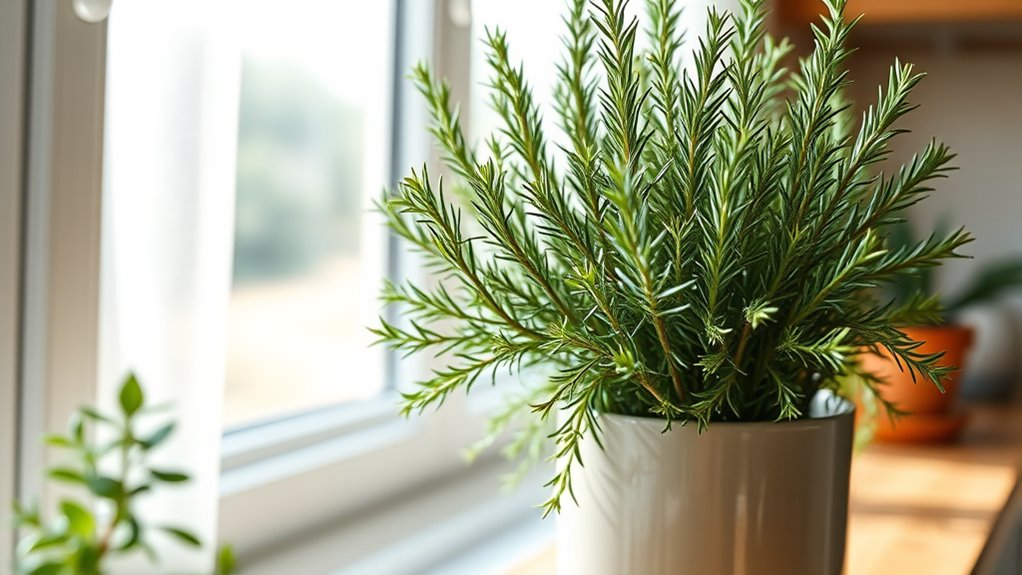To care for potted rosemary indoors, place it where it gets at least 6 hours of bright, direct sunlight daily—near a south-facing window is ideal. Water thoroughly when the top inch of soil feels dry, ensuring excess drains out to prevent root rot. Use well-drained soil and avoid overwatering, especially in cooler months. Adjust your watering and light routine seasonally for healthy, aromatic growth; learn more about perfecting your care routine below.
Key Takeaways
- Water thoroughly when the top inch of soil feels dry, ensuring excess drains from the pot’s bottom.
- Provide at least 6 hours of bright, direct sunlight daily, ideally near a south-facing window.
- Use well-drained soil to prevent waterlogging and root rot; adjust watering frequency seasonally.
- Avoid intense afternoon sun to prevent leaf scorch; move the plant seasonally for optimal light exposure.
- Increase watering and light in warmer months, and reduce both in cooler, humid seasons for healthy growth.

Growing potted rosemary indoors is a rewarding way to enjoy fresh herbs year-round, but it requires understanding its specific care needs. One of the most important aspects is establishing a proper watering schedule. Rosemary prefers well-drained soil and doesn’t like to sit in water, so you should water it thoroughly when the top inch of soil feels dry. Typically, this means watering every 1-2 weeks, but it can vary based on your home’s humidity and temperature. During warmer months or in dry indoor environments, you might need to water a bit more frequently. Conversely, in cooler, more humid conditions, cut back to prevent overwatering. Always check the soil moisture before watering to avoid root rot, which rosemary is particularly susceptible to. If the soil feels moist, hold off on watering until it dries out a bit. When you do water, do so until excess water drains from the bottom of the pot to guarantee even moisture absorption and prevent pockets of dry soil. Adjust your watering routine as the seasons change to keep your rosemary healthy.
Sunlight requirements play a vital role in keeping your potted rosemary thriving indoors. Rosemary loves bright, direct sunlight, ideally at least 6 hours a day. Place your pot near a south-facing window where it can soak up the maximum amount of sunlight. If natural light is limited, especially during winter months, consider supplementing with a grow light designed for herbs. Lack of sufficient sunlight can lead to leggy growth, weak stems, and a dull flavor in the leaves. If you notice your rosemary stretching or leaning toward the light, it’s a sign you need to move it to a sunnier spot. Conversely, avoid intense, direct afternoon sun that can scorch the leaves, especially if your windows are hot or the sun is particularly strong. Maintaining the right sunlight exposure helps your rosemary develop aromatic, flavorful leaves and keeps it vigorous.
Frequently Asked Questions
How Often Should I Prune My Indoor Rosemary?
You should prune your indoor rosemary about every 4 to 6 weeks, depending on its growth. Regular pruning encourages bushier growth and maintains its shape. Incorporate seasonal trimming to remove dead or leggy stems, especially in spring and summer when it grows fastest. Always prune after the plant has finished blooming to promote healthy new growth. Remember, consistent pruning keeps your rosemary vigorous and flavorful.
Can Rosemary Thrive in Low Humidity Environments Indoors?
You might think rosemary won’t thrive in low humidity, but it can tolerate indoor climate fluctuations better than you expect. While ideal humidity levels boost its growth, rosemary adapts to drier air, especially if you guarantee good airflow and avoid overwatering. Keep in mind, consistent care matters. So, even in low humidity environments, your rosemary can flourish if you provide proper light, watering, and ventilation.
What Are Common Pests That Affect Indoor Rosemary Plants?
You should watch for common pests like spider mites, aphids, and whiteflies that can affect your indoor rosemary. Pest identification helps you spot these issues early. When you notice pests, try natural remedies like insecticidal soap or neem oil to control them without harsh chemicals. Regularly inspecting your plant keeps pests at bay, ensuring your rosemary stays healthy and vibrant indoors.
Is It Necessary to Fertilize Rosemary During Winter?
Yes, you should fertilize your rosemary during winter, but sparingly. Follow a watering schedule that keeps the soil slightly moist, not waterlogged. Make sure it gets plenty of sunlight, ideally 6-8 hours daily, to support growth. Use a balanced, diluted fertilizer once a month. This helps maintain healthy foliage and prevents nutrient deficiencies despite reduced growth in colder months.
How Can I Prevent Root Rot in Potted Rosemary?
In the age of dial-up internet, you can prevent root rot in your potted rosemary by ensuring proper soil drainage and adjusting your watering frequency. Water only when the top inch of soil feels dry, avoiding overwatering. Use well-draining soil and a pot with drainage holes. This keeps excess moisture away from roots, helping your rosemary thrive indoors without the threat of root rot.
Conclusion
With a little love and attention, your potted rosemary will thrive like a fragrant garden in your windowsill, filling your space with its invigorating aroma. Think of it as your green companion, quietly cheering you on with every leaf. Nurture it patiently, and it’ll reward you with lush greenery and endless inspiration. Let your care be the gentle breeze guiding this herb’s journey to flourish, turning your home into a fragrant sanctuary you’ll cherish every day.









